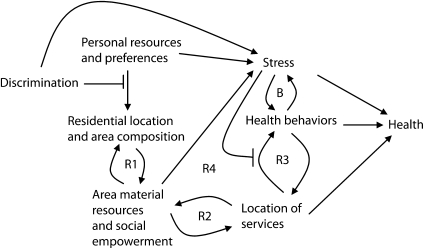FIGURE 5.
Dynamic relations between area factors, individual-level factors, and health outcomes.
Note. A single-headed arrow for X to Y indicates that X is a cause of Y or that X causes increased exposure to Y. A line intersecting a 1-headed arrow (in the form of a T) indicates that the factor modifies or modulates the relation between X and Y (e.g., discrimination modifies the relation between personal resources/preferences and residential location, and stress modifies the relation between location of services and behaviors). Positive or negative feedback loops are indicated with an R (reinforcing) or a B (balancing). Reinforcing loops promote or reinforce change in one direction. Balancing loops tend to close the gap between the current state and the desired state (e.g., increases in stress result in health behaviors that reduce stress levels bringing the body back into its desired state).

